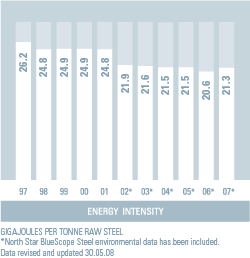Energy Use
|
The manufacture and processing of iron and steel uses large quantities of energy. The majority of energy used (about 84 per cent) is from coal and coke used in the chemical process of making iron. Gases generated from the use of coal in the steelmaking process are captured and used for heating processes, reducing the need to purchase additional sources of energy. Natural Gas (about 10%) and electricity (about 7%) make up the majority of remaining energy use. We are currently conducting a feasibility study for a co-generation plant at Port Kembla Steelworks. If built, a co-generation plant would capture additional gases from the steelmaking process. After reducing energy consumption from 139.3 petajoules per annum in FY1997 to as low as 133.1 petajoules in FY2002, BlueScope Steel’s total global energy consumption has risen, increasing to 147.1 petajoules in FY2007. This increase mainly reflects greater electricity and gas consumption as a result of the opening of new mid-stream and downstream production facilities, as well as increased production of export coke in FY2007. Over the last 10 years, BlueScope Steel has reduced its energy intensity at Port Kembla Steelworks by approximately 8 per cent. This was achieved through a range of incremental measures, including energy efficiency projects. Energy intensity for the Company globally has remained stable over the last five years, at approximately 21 gigajoules per tonne of raw steel manufactured. The significant drop in energy intensity from 24.8 gigajoules in 2001 to 21.9 gigajoules in 2002 was a result of including data from North Star BlueScope Steel. |


